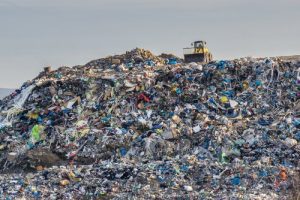The clothing industry and its products affect the environment in a big way.
Negative impact on the environment begins during production, and continues to have consequences throughout the life-cycle. Quite possibly the biggest issue is that most textiles are simply thrown away after being used.
Most used clothing ends up in landfill, and a lot of that gets incinerated. This results in the industry wasting even more energy and water.
The good news, however, is that industries focused on recycling and reusing textile are slowly emerging and getting stronger. Bank & Vogue is proud to play a role in this!
Given that textiles also contribute a lot to greenhouse gas emissions, it’s important to take steps towards textile recycling and to improve all the practices that go along with it. For this and many other reasons, recycling textiles can help save the environment and establish a circular economy that will save money.
Textile recycling defined

Let us first define “textile recycling.” This is a process of gathering various textiles and clothing and recovering them for further material use or reusing them as clothes once again. The recycling industry in the United States is regulated by SMART (Association of Wiping Materials, Used Clothing, and Fiber Industries).
General textile recycling steps include:
- Donation
- Gathering
- Storing
- Processing
- Transpiration
The end products are delivered to new users or to other industries where they can be used for different products. Apart from being beneficial for the environment, textile recycling has also become a fruitful global industry, worth over $1 trillion.
Why textile recycling is an urgent issue
The importance of textile recycling is growing each year. The worldwide annual production of garments has exceeded 80 billion, and the EPA reports that the textile MSW (municipal solid waste) accounts for around 6% of the total number.
At the moment, the textiles derived from used footwear and clothing amounts to approximately 15%, meaning that there is still a long way to go with textile recycling. Since most of the textile materials are still thrown away, we have much more to accomplish before we can completely remove the need for landfills.
The total amount of textiles which were recycled in 2015 is 2.5 million tons, meaning there are approximately 20 more tons that are not recycled. More accurately, around 10 million tons of textile MSW were put into landfills. In the US, the amount of pre-consumer waste recycled is at around 75%, but it’s only 15% for post-consumer waste.
Textile recycling reduces greenhouse gas emission

A big portion of clothes that we wear today are made out of various organic materials which are biodegradable and derived straight out of natural resources. In theory, once thrown away, these materials will degrade naturally with no consequences.
However, things don’t work like that in reality. As most of the textile is thrown away in landfills, all the organic materials are covered up, and they don’t have any oxygen. Why is this important? Oxygen is necessary for organic materials to break down.
Instead, these textiles go into a process of anaerobic digestion, which leads to greenhouse gas emissions. These gases aren’t controlled in any way, and they end up scattered around the atmosphere.
It helps people in countries that are still developing
A lot of old clothes that get recycled are sent to developing countries, where they are sold at affordable prices. Simply put, instead of being thrown out into harmful landfills, clothes are gathered, stored, refinished, and transported to developing countries, where they can be used for a long time.
It saves a lot of resources and materials. Rather than forcing the clothing industry to produce low-quality products made out of unsafe materials, people in developing countries can buy undamaged second-hand clothes at very low prices.
Providing such opportunities is yet another way the circular economy is kept alive and how recyclers are able to make money while giving consumers products that they are happy with.
It saves energy
 The clothing industry spends a lot of energy to produce new products. They go through a long and complex process of manufacturing, which requires a lot of water and electricity. As the recycling industry grows, the demand for new clothes will drop, which means that companies will spend less energy on manufacturing new items.
The clothing industry spends a lot of energy to produce new products. They go through a long and complex process of manufacturing, which requires a lot of water and electricity. As the recycling industry grows, the demand for new clothes will drop, which means that companies will spend less energy on manufacturing new items.
At the same time, as consumers are becoming more conscious about the environment and turning to recycling, the big clothing companies are starting to join in the reduce-reuse-recycle phenomenon as well. In fact, they will be able to retain their profits by offering more environmentally-friendly products.
Furthermore, even though uncontrolled incineration of textiles is a bad thing that harms the environment, there are new, more environmentally conscious facilities that have a different process in place.
The incineration is done in a safe way that doesn’t release energy or chemicals into the environment, and the energy is used to reduce the costs of other industries.
Reduced use of landfills
Landfills are out of sight, and because of that, most people don’t think they exist. But did you know that over 12 million tons of different textiles end up in landfills each year? Not only is this practice severely damaging to the environment, it also costs a lot.
Landfills are very expensive to purchase, and they require a lot of open space. Additionally, they cost millions to operate, and this money comes from municipalities and cities – from the taxpayers’ pockets! Recycling steadily cuts down these costs and removes the need for creating new landfills.
How Bank & Vogue makes a positive impact
The whole world is drowning in old clothes, and as pollution is becoming a hot topic, the only sensible option is to recycle. Luckily, the textile recycling industry is rapidly developing in many countries around the world, as a part of the circular economy, which means that recycling no longer costs money – it brings revenue.
To find out more about the role Bank & Vogue is playing in the Circular Economy, contact us today.







